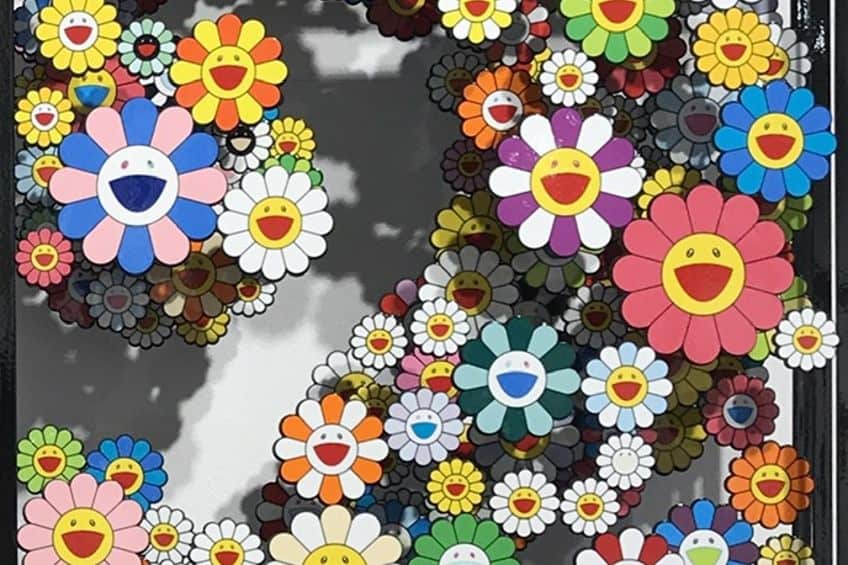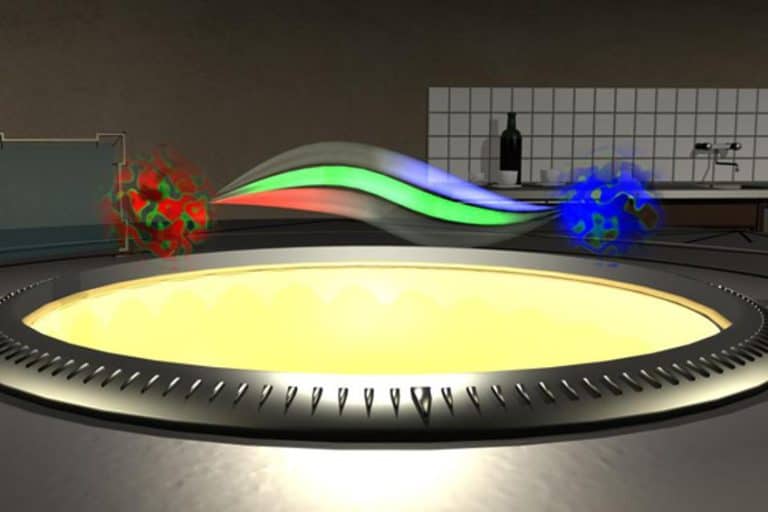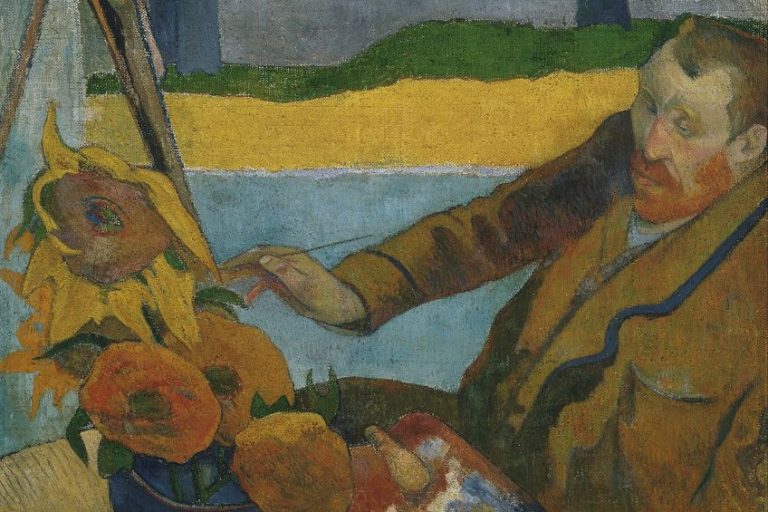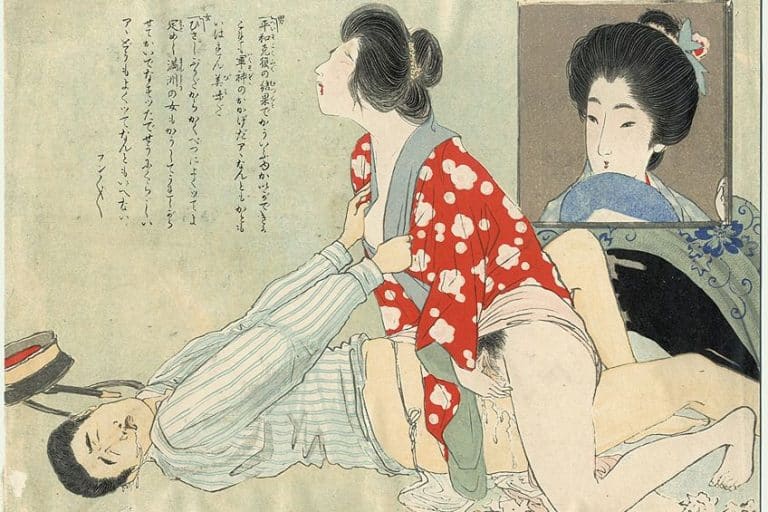Superflat Art – The Contemporary Japanese Pop Movement
The art world has always been a canvas for boundless creativity, constantly evolving to encompass new perspectives and styles. Among the intriguing movements that have emerged, the Superflat movement stands out as a captivating blend of tradition and modernity. Spearheaded by visionary artists like Takashi Murakami, the Superflat artists have garnered global attention for their unique fusion of pop culture, traditional Japanese art, and contemporary aesthetics. In this article, we delve into the essence of Superflat art, exploring its origins, defining features, and the prominent role it occupies within the realm of Superflat Japanese art. Join us as we unravel the intricate layers of this fascinating artistic phenomenon and shed light on its enduring influence!
Unveiling the Art Historical Evolution of Superflat: What Is Superflat Art?
In the dynamic tapestry of art history, certain movements arise that not only challenge conventions but also reshape the very fabric of artistic expression. The Superflat movement, a distinctive and captivating art style, has undeniably left an indelible mark on the contemporary art scene, particularly within Japanese creativity. Spanning from its inception to its profound influence on the evolution of modern Japanese art, this section of the article delves into the multifaceted journey of Superflat, examining its origins, the motivations that drew artists to it, its symbiotic relationship with preceding art movements, and its transformative impact on the broader artistic landscape.

The Genesis of Superflat
The roots of the Superflat movement can be traced back to the artistic vision of the renowned Japanese artist Takashi Murakami. Emerging in the 1980s, Superflat marked a departure from traditional artistic conventions by embracing a distinct aesthetic that fused elements of pop culture, commercial art, and traditional Japanese visual motifs.
Murakami coined the term “Superflat” to encapsulate this novel approach, which aimed to flatten the boundaries between high and low art, reflecting the influence of consumer culture and the proliferation of flat, two-dimensional imagery in contemporary society.
Attraction to Superflat
Artists gravitated toward the Superflat movement for many reasons. One compelling aspect was its capacity to subvert conventional hierarchies, democratizing art by elevating everyday objects and pop culture references to the realm of high art. This departure from elitism resonated with artists seeking to challenge established norms and bridge the gap between artistic disciplines.
Additionally, the movement’s engagement with kawaii culture—a celebration of cuteness—captured the imagination of both artists and audiences, offering a refreshing departure from more traditional notions of beauty and aesthetics. This emphasis on cuteness and childlike wonderment resonates with a broader cultural fascination with innocence and simplicity. Superflat’s influence on kawaii culture has extended to diverse realms, from fashion trends to design choices, imbuing them with a sense of playfulness and whimsy. The movement’s embrace of kawaii aesthetics has contributed to a shift in societal attitudes toward embracing childlike joy and embracing the concept of “grown-up playfulness.” Artists inspired by Superflat are encouraged to draw inspiration from everyday objects, consumer products, and pop culture references, advancing them to the status of fine art.
This influence has permeated not only the art world but has also found resonance in fashion, design, and commercial aesthetics, blurring the lines between artistic domains and inviting audiences to engage with art on multiple levels.
Precursors and Influences
The rise of Superflat was significantly influenced by earlier art movements that laid the groundwork for its emergence. Notably, the movement draws inspiration from the ukiyo-e woodblock prints of Japan’s Edo period, which featured flattened perspectives and vivid imagery. The Minimalist movement’s emphasis on simplicity and reduction also informed Superflat’s aesthetic choices, as did Pop Art’s embrace of consumerism and mass culture. These influences intertwined to create a unique visual language that resonated with contemporary audiences while honoring Japan’s artistic heritage.

Superflat’s Impact on Contemporary Japanese Art
The Superflat movement has had a profound and lasting impact on the trajectory of contemporary Japanese art. Its fusion of high and low culture has prompted artists to explore new horizons, blurring the lines between fine art, commercial art, and popular culture. By challenging established boundaries, Superflat has expanded the scope of artistic expression and encouraged a reimagining of traditional artistic mediums.
Moreover, the movement’s global recognition has helped elevate Japanese art to international prominence, fostering cross-cultural exchanges and inspiring a new generation of artists to explore innovative creative avenues.
The Multifaceted Influences of the Superflat Movement: Shaping Art and Culture
Beyond its distinctive aesthetic, Superflat has exerted a far-reaching influence, weaving its threads into the realms of art, popular culture, and societal perceptions. This section of the article delves deeper into the intricate web of influences that have shaped and been shaped by the Superflat movement, revealing its profound impact on various facets of contemporary existence.
Reflections on Consumerism and Globalization
Superflat’s emergence in the 1980s and 1990s coincided with a period of rapid globalization and the ascendancy of consumer culture. This temporal alignment is no coincidence, as Superflat serves as a reflective mirror to societal shifts. The movement’s incorporation of commercial iconography, vibrant colors, and references to anime and manga speaks to the pervasive influence of consumerism on contemporary existence.
It serves as a commentary on the commodification of culture and the ways in which consumer products shape our identities and aspirations.
Cross-pollination and Global Recognition
The Superflat movement’s impact has transcended geographic boundaries, fostering cross-pollination between Eastern and Western artistic sensibilities. As Superflat gained international recognition, it facilitated cultural exchanges and dialogues, encouraging artists from different corners of the world to engage with its themes and aesthetic choices. This global reach has not only expanded the movement’s influence but has also enriched the creative discourse by encouraging a dynamic interplay of perspectives and ideas.
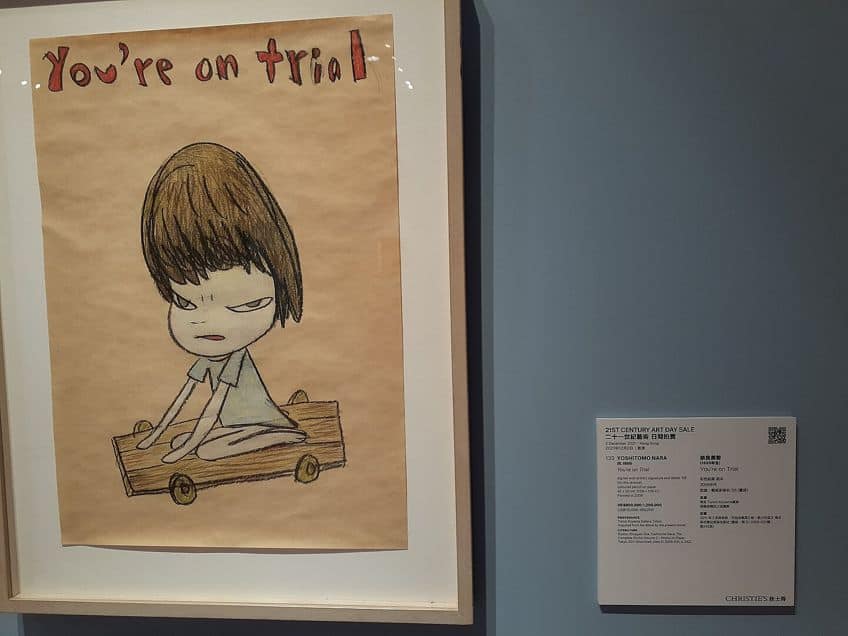
The Artistic Anatomy of Superflat: Deconstructing Technical Characteristics
In the realm of contemporary art, the Superflat movement stands as a remarkable fusion of innovation and tradition, challenging established artistic norms with its distinctive visual language. As artists channel their creativity through this unique lens, a meticulous interplay of technical characteristics comes to the forefront, defining the movement’s aesthetic essence.
From the crisp lines and flattened perspectives to the vibrant palette and kawaii-inspired motifs, this section of the article dissects the technical artistic characteristics that underpin Superflat art, shedding light on how they coalesce to create a captivating visual experience.
Flattened Perspectives and Two-Dimensionality
Central to the Superflat movement is its deliberate embrace of two-dimensionality, a trait that harks back to traditional Japanese art forms like ukiyo-e woodblock prints. Superflat artists employ flattened perspectives, minimizing the illusion of depth and inviting viewers into a realm that blurs the boundaries between the physical and the imaginary. This technique evokes a sense of visual immediacy, creating a dynamic interplay between foreground and background that challenges conventional spatial conventions.
Bold Line Work and Graphic Precision
One of the hallmarks of Superflat art lies in its bold and precise line work. Artists meticulously outline their subjects, using clean, graphic lines to define forms and contours. This emphasis on linework imbues the compositions with a sense of clarity and simplicity, facilitating a direct engagement between the viewer and the artwork.
The graphic precision of Superflat not only enhances the visual impact but also serves as a deliberate departure from more nuanced and shaded approaches.
Vibrant Color Palette and Pop Aesthetics
Vivid and vibrant, the color palette of Superflat art is a testament to its pop culture origins. Artists draw from an expansive range of hues, often employing bold primaries and complementary shades to create striking visual contrasts. This color spectrum not only captures attention but also contributes to the movement’s playful and dynamic character. The harmonious interplay of colors enhances the flatness of the compositions while infusing them with a sense of energy and vibrancy.
Kawaii Culture and Cuteness
An inherent element of Superflat’s technical repertoire is its incorporation of kawaii culture. The movement often features characters, animals, and objects rendered adorably and endearingly. The charming and whimsical portrayal of subjects not only invokes a sense of nostalgia.
It invites viewers to engage with the artwork on an emotional level, fostering a connection that transcends cultural and linguistic boundaries.
Simplified Detail and Visual Economy
Superflat artists are skilled in the art of simplification, distilling complex subjects into essential forms and shapes. This technique enhances the movement’s two-dimensional aesthetic while imbuing the compositions with a sense of visual economy. By minimizing extraneous details, artists direct the viewer’s gaze toward the essential components of the artwork, creating a focal point that captures attention and facilitates immediate comprehension.

Superflat Japanese Artists
The realm of contemporary art has been illuminated by a constellation of creative luminaries, each contributing a unique and distinct hue to the canvas of artistic expression. Among these stars, the Superflat movement has birthed a cohort of remarkable artists whose contributions have transcended cultural boundaries and captivated global audiences. Takashi Murakami, Yoshitomo Nara, Chiho Aoshima, and Aya Takano are four luminous figures who have masterfully navigated the realm of Superflat, infusing it with their individual visions and artistic signatures.
With their diverse styles and imaginative prowess, these artists have collectively shaped the movement’s trajectory, propelling Superflat into the vanguard of contemporary artistic discourse.
Yoshitomo Nara (1959 – Present)
| Date of Birth | 5 December 1959 |
| Age | 63 years old |
| Place of Birth | Hirosaki, Aomori, Japan |
| Nationality | Japanese |
| Associated Art Movements | Superflat and Pop art |
Yoshitomo Nara, a luminary within the realm of contemporary art, emerges as a masterful storyteller whose canvas becomes a portal into a world that traverses the boundaries of innocence and introspection. With an unwavering commitment to his signature style, Nara’s artwork embodies a delicate interplay between childlike wonderment and the profound complexities of the human experience. His iconic subjects, often portrayed with wide, enigmatic eyes and emotive expressions, draw viewers into an evocative narrative that is at once universal and deeply personal. Nara’s evocative exploration of memory, vulnerability, and cultural identity reverberates through his compositions, inviting contemplation and forging connections that resonate far beyond the confines of the canvas. Through his intimate reflections on the human condition, Nara’s art becomes a mirror reflecting the intricacies of existence and an enduring invitation to explore the enigmatic depths of the self.
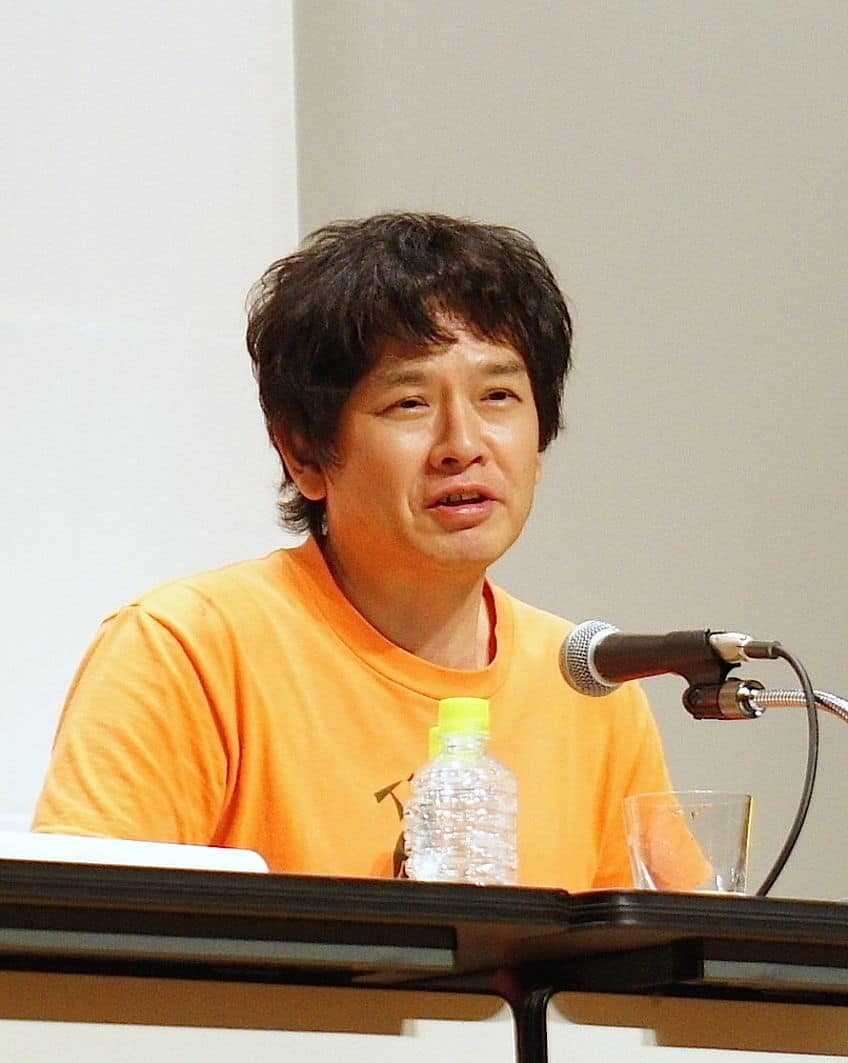
The Girl with the Knife in Her Hand (1991)
| Title | The Girl with the Knife in Her Hand |
| Date | 1991 |
| Medium | Acrylic on canvas |
| Dimensions (cm) | 150.5 × 140.02 × 2.22 |
| Art Movement | Superflat |
| Location | San Francisco Museum of Modern Art, California, United States |
The Girl with the Knife in Her Hand, a compelling artwork by Yoshitomo Nara, presents a poignant and enigmatic tableau that immediately captures the viewer’s attention. The central figure, a young girl clutching a knife, is rendered with precision and detail, her oversized, hauntingly intense eyes drawing one into her world. The juxtaposition of innocence and potential danger is palpable, with the girl’s seemingly calm demeanor and the sharp implement she holds creating a sense of tension and ambiguity. The artist’s use of a mixed color palette, primarily shades of purple and red tones, imparts a somber atmosphere, further accentuating the emotional weight of the composition. The simplicity of the composition and the focused attention on the girl’s expression create an intimate and arresting visual experience.
The Girl with the Knife in Her Hand encapsulates Yoshitomo Nara’s uncanny ability to convey complex emotions and psychological depth through his art.
The image of a child holding a knife serves as a metaphorical exploration of the duality that exists within human nature. The girl’s piercing gaze and resolute grip on the knife evoke a sense of agency and determination, symbolizing the potential for empowerment and self-defense. At the same time, her youthful innocence remains evident, underscoring the vulnerability and malleability inherent in growing up.
The composition’s open-ended narrative invites viewers to engage in a dialogue surrounding themes of empowerment, vulnerability, and the blurred line between protection and aggression. Nara’s depiction of the girl’s eyes, which appear to convey a mix of curiosity, resolve, and contemplation, prompts reflection on the internal struggles that individuals, regardless of age, navigate as they confront challenges and uncertainties.
In a broader cultural context, the artwork can be seen as a commentary on societal expectations, particularly the pressures placed upon individuals to conform to prescribed roles and behaviors. The girl’s juxtaposition of innocence and potential danger reflects the societal tensions between protecting and empowering the vulnerable while acknowledging the potential for aggression or defiance.
Takashi Murakami (1962 – Present)
| Date of Birth | 1962 |
| Age | 61 years old |
| Place of Birth | Itabashi City, Tokyo, Japan |
| Nationality | Japanese |
| Associated Art Movements | Superflat and Pop art |
Takashi Murakami, a trailblazing figure in the realm of contemporary art, stands as a visionary who seamlessly melds the worlds of traditional Japanese culture, pop iconography, and avant-garde aesthetics. Recognized as the progenitor of the Superflat movement, Murakami’s oeuvre is a mesmerizing exploration of the intersection between high and low art, invoking a vibrant fusion of commercial imagery and classical motifs. With a signature style characterized by bold lines, kaleidoscopic colors, and an enchanting embrace of kawaii culture, Murakami’s artistic journey transcends conventional boundaries, inviting viewers into a realm where innocence meets irony and whimsy converges with profound social commentary.
Through his vibrant canvases, sculptures, and collaborations, Murakami illuminates the dynamic interplay between tradition and modernity, challenging artistic norms and inspiring a new generation of creators to reimagine the possibilities of creative expression.
Flowerball (2002)
| Title | Flowerball |
| Date | 2002 |
| Medium | Acrylic on canvas and wood |
| Dimensions (cm) | 100.3 diameter |
| Art Movement | Superflat and Abstract art |
| Location | Museum Of Contemporary Art Chicago, Illinois, United States |
Flowerball, a captivating artwork by Takashi Murakami, beckons viewers into a realm of vibrant colors and dynamic forms. At first glance, the composition exudes a sense of exuberance and playfulness, with its larger-than-life proportions and whimsical arrangement of oversized flowers. The meticulous attention to detail is evident in the intricate patterns that adorn each petal, resembling a harmonious fusion of traditional Japanese floral motifs and contemporary pop aesthetics. The artist’s use of bold, primary colors—radiant reds, electric blues, and sunny yellows—creates a visual symphony that arrests the eye, drawing the viewer deeper into a world where the boundaries between nature and artifice blur.
Flowerball serves as a quintessential embodiment of Takashi Murakami’s artistic philosophy, encapsulating his penchant for bridging cultural divides and exploring the multifaceted layers of contemporary existence. The artwork’s fusion of traditional Japanese floral imagery with the audacious energy of pop culture reflects Murakami’s profound engagement with the dichotomies inherent in modern society. The oversaturation of colors and the larger-than-life scale of the flowers invoke a sense of consumerism and commercialism, drawing parallels to the mass-produced and commodified nature of contemporary culture.
However, beneath the surface of exuberance lies a nuanced commentary on the tension between authenticity and artifice. The meticulously crafted flowers, while aesthetically captivating, also allude to the artificiality that often permeates our surroundings.
The deliberate use of scale magnifies this tension, as the viewer is confronted with an overwhelming profusion of beauty that simultaneously questions its genuineness.
Furthermore, Flowerball embodies the Superflat movement’s ethos of merging high and low art forms. By portraying the flowers as if plucked from the realms of both classical Japanese art and animated cartoons, Murakami blurs the lines between the sacred and the everyday, inviting viewers to reassess their preconceived notions of artistic hierarchy.
Chiho Aoshima (1974 – Present)
| Date of Birth | 1974 |
| Age | 49 years old |
| Place of Birth | Tokyo, Japan |
| Nationality | Japanese |
| Associated Art Movements | Superflat |
Chiho Aoshima emerges as a captivating voice within the contemporary art landscape, weaving together ethereal landscapes, intricate patterns, and fantastical narratives that traverse the realms of dreams and reality. With a distinctive artistic approach that merges traditional Japanese aesthetics with modern digital techniques, Aoshima’s oeuvre unfolds as a mesmerizing tapestry of surrealism and symbolism. Her works, often characterized by vibrant colors, otherworldly creatures, and intricate detailing, invite viewers into a realm where the boundaries between the natural and supernatural blur. Through her evocative imagery, Aoshima delves into themes of nature, spirituality, and the human connection to the cosmos, inviting us to embark on a visual journey that challenges perceptions and beckons us to explore the enigmatic depths of existence.
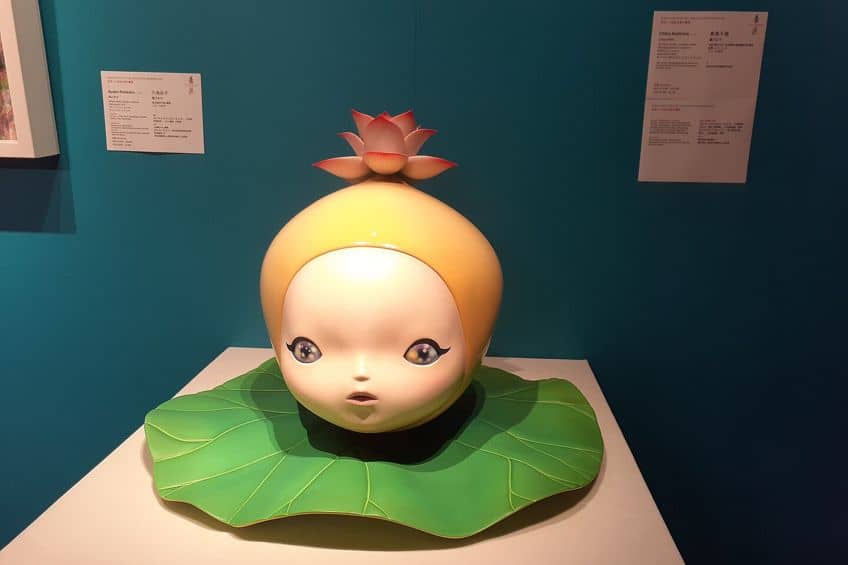
Paradise (2001)
| Title | Paradise |
| Date | 2001 |
| Medium | Offset lithograph laid on aluminum |
| Dimensions (cm) | 99 x 270 |
| Art Movement | Superflat |
| Location | N/A |
Paradise, a captivating artwork by Chiho Aoshima, immerses the viewer in a lush and fantastical world that seems to transcend the boundaries of reality. The composition envelops the viewer in a symphony of vibrant hues, with lush greenery, flowing waterfalls, and intricate flora dominating the scene. The meticulous attention to detail is evident in the intricate patterns that adorn the landscape, resembling a harmonious fusion of traditional Japanese motifs and contemporary digital aesthetics. The ethereal glow that suffuses the environment casts an otherworldly aura, inviting the viewer to partake in an enchanting journey through a realm that exists beyond the confines of the everyday.
Paradise embodies Chiho Aoshima’s adept ability to seamlessly blend the natural and the supernatural, offering a glimpse into a dreamscape that balances the awe-inspiring beauty of nature with a sense of mystical wonder.
The title itself alludes to an idyllic and utopian realm, where the familiar is transmuted into the extraordinary. Aoshima’s meticulous attention to detail, coupled with her use of digital techniques, creates a paradoxical sensation of both hyper-realism and dreamlike abstraction.
At its core, Paradise beckons viewers to explore their perceptions of nature, the environment, and their place within it. The composition’s mesmerizing fusion of the organic and the surreal prompts contemplation of humanity’s relationship with the natural world. Aoshima’s use of exaggerated scale and fantastical elements underscores the interconnectedness between the human imagination and the Earth’s ecosystems, inviting us to consider how our perceptions of nature are imbued with both reverence and artistic interpretation.
Furthermore, the work conveys a sense of harmony and balance between opposing forces. The juxtaposition of calm, flowing waterfalls, and dynamic, swirling patterns suggest a coexistence of tranquility and motion, echoing the delicate equilibrium that exists within nature itself. This balance resonates on a deeper level, touching on themes of human interconnectedness, emotional well-being, and the pursuit of personal utopias.
In Paradise, Chiho Aoshima delves into the confluence of nature, spirituality, and artistic imagination, inviting viewers to contemplate the interplay between the tangible and the intangible, the real and the imagined.
Through her exquisite craftsmanship and evocative imagery, Aoshima challenges us to reevaluate our understanding of the natural world and its profound impact on our collective consciousness, encouraging us to embark on an introspective voyage through the realms of beauty, transcendence, and the ever-shifting boundaries of human perception.
Aya Takano (1976 – Present)
| Date of Birth | 22 December 1976 |
| Age | 46 years old |
| Place of Birth | Saitama, Saitama, Japan |
| Nationality | Japanese |
| Associated Art Movements | Superflat and Pop art |
Aya Takano, a luminary within the realm of contemporary art, unfolds as a visionary who masterfully navigates the boundaries between the terrestrial and the celestial. With an ethereal touch that melds the realms of the human and the divine, Takano’s artistry casts a spellbinding spell, inviting viewers to traverse a dreamscape where reality interweaves with imagination. Through her distinct fusion of fine brushwork and otherworldly subject matter, Takano creates compositions that explore the intricate threads that connect the cosmos, humanity, and the ethereal unknown. Her delicate depictions of otherworldly landscapes, celestial beings, and introspective narratives beckon us to contemplate the mysteries of existence and our place within the vast tapestry of the universe. Through her evocative canvases, Takano invites us to embark on a transcendent journey, one that unravels the layers of reality and illuminates the boundless dimensions of the human spirit.
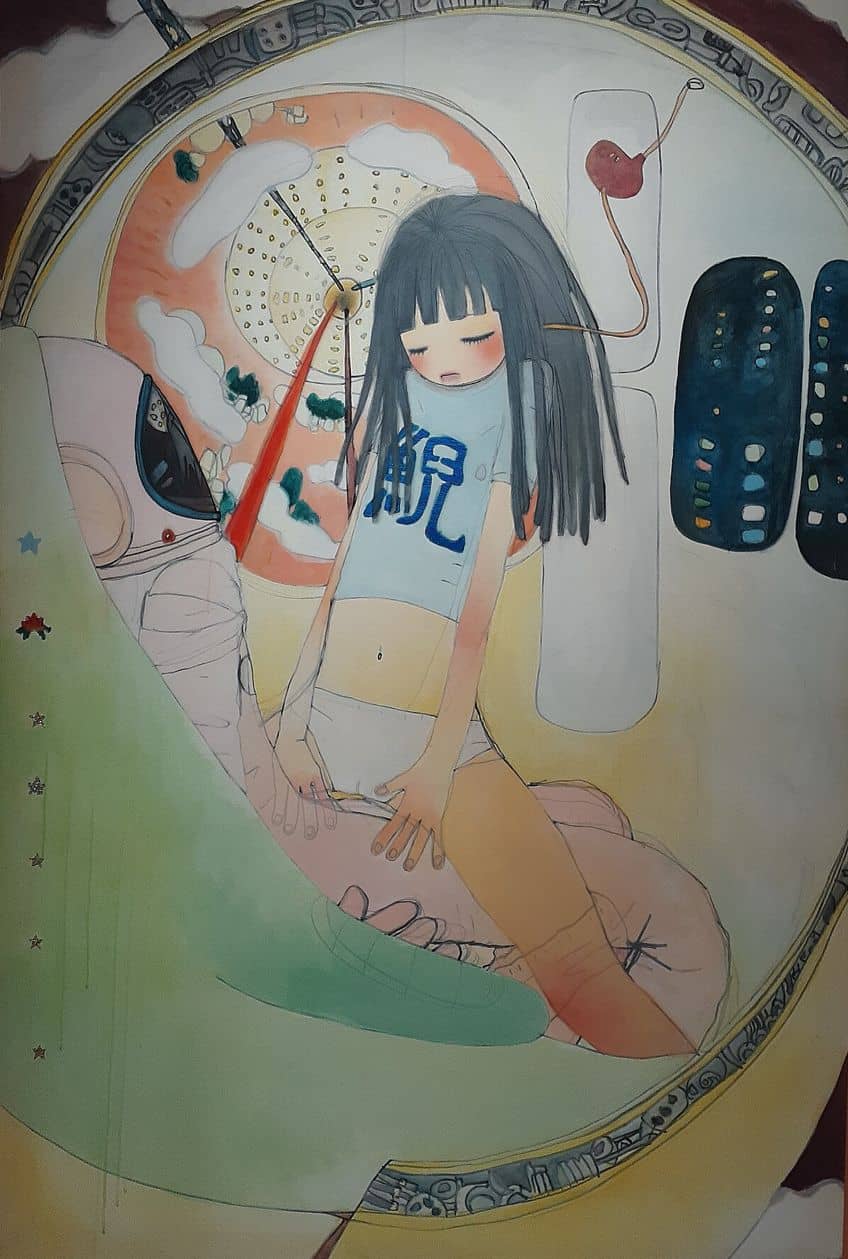
Shibuya Sprint (2020)
| Title | Shibuya Sprint |
| Date | 2020 |
| Medium | Watercolor and pen on paper |
| Dimensions (cm) | 25 × 17.5 |
| Art Movement | Superflat and Pop art |
| Location | Perrotin Gallery, Huangpu District, Shanghai, China |
Aya Takano’s artwork Shibuya Sprint (2020) immediately seizes the viewer’s attention with its dynamic composition. The focal point of the piece is a bustling cityscape that unmistakably represents a train or subway station in Shibuya. The graffiti adorning the subway walls is depicted in vivid shades of pink, electric blue, and vibrant yellow, capturing the vibrant energy and futuristic ambiance of Tokyo.
In the foreground, a young girl is portrayed mid-sprint, exuding a sense of frenzied urgency. Her graceful movements are echoed by a mouse and squirrel companion sprinting alongside her, all against the backdrop of the cityscape. These elements, in conjunction with the urban setting, contribute to the creation of a surreal and dreamlike atmosphere. The artwork is an intricate tapestry of lively colors and meticulous details, beckoning viewers to explore its enigmatic narrative further.
Shibuya Sprint transcends being a mere depiction of urban life, evolving into a profound commentary on the intricate facets of modern existence.
The artwork serves as a visual allegory for the fast-paced and interconnected nature of contemporary society, with Shibuya symbolizing Tokyo’s bustling metropolis. The characters’ fervent sprinting motions symbolize the ceaseless pursuit of achievement, contentment, and purpose that characterizes city living, portraying individuals entrapped in an incessant race toward an elusive destination.
Takano’s central character defies societal norms, portraying a young girl actively participating in the urban frenzy. This stance underscores the impact of city life on youth, as they are thrust into the rat race from an early age. By doing so, the artist highlights the consequences of urban living on young individuals who navigate a rapid-paced existence.
The surreal presence of the animals reflects the influence of technology and digitization on children’s perceptions of reality and human connections. They symbolize the compromise of their playful and imaginative nature, a consequence of the digital age. However, the joyful and pleasing colors employed in the painting could also be interpreted as a celebration of the city’s vibrant culture.
In its entirety, Shibuya Sprint invites contemplation on the human journey within the modern urban landscape. Takano’s art encourages viewers to scrutinize the essence of modernity, the pursuit of identity and self-discovery, as well as the implications of unrelenting consumerism and technological advancement. The artwork, while celebrating the dynamism of city life, simultaneously serves as a poignant reminder of the necessity for self-reflection and human connection amidst the frantic sprint of existence.
The Superflat movement has emerged as a profound and captivating force, forever altering the landscape of creativity within the realms of contemporary art. As we conclude our exploration into the realm of Superflat art, we find ourselves immersed in a world where high and low culture intersect, and where traditional aesthetics meld seamlessly with modern innovation. The legacy of Superflat art, championed by visionary Superflat artists like Takashi Murakami, transcends mere visual aesthetics; it encapsulates a profound statement on the collision of cultural paradigms, inviting us to question our perceptions of reality and challenge societal norms. Superflat art’s unique amalgamation of pop culture, traditional influences, and cutting-edge techniques propels us into an introspective journey through the vibrant tapestry of Superflat Japanese art. It beckons us to embrace the flattened perspectives, vibrant colors, and playful whimsy that define the movement, reminding us that within its seemingly simple façade lies a complex commentary on the multifaceted layers of our contemporary world.
Frequently Asked Questions
What Is Superflat Art?
Superflat art is a distinctive artistic movement that originated in Japan, characterized by its flattened and two-dimensional aesthetic that blurs the boundaries between high and low culture. Coined by renowned artist Takashi Murakami, Superflat art merges traditional Japanese artistic elements with contemporary pop culture references. It embraces a playful and often vibrant visual language, featuring bold lines, bright colors, and simplified forms. Beyond its surface appeal, Superflat art carries a deeper social and cultural commentary, challenging artistic hierarchies and reflecting the influence of consumerism, technology, and globalized media on modern society.
What Are the Characteristics of Superflat Art?
Superflat art is characterized by a distinct set of visual and thematic features that set it apart within the artistic landscape. Its hallmark traits include flattened perspectives, vibrant and bold color palettes, meticulous linework, and an amalgamation of traditional Japanese motifs with contemporary pop culture elements. The movement often embraces a playful and whimsical tone, showcasing characters and subjects that exude a sense of innocence and cuteness, influenced by the kawaii culture. Superflat art challenges conventional artistic hierarchies by celebrating everyday objects and mass-produced imagery, blurring the lines between high and low art forms. Beyond its aesthetic appeal, Superflat art frequently carries layers of social commentary, critiquing consumerism, globalization, and the complexities of modern existence.
Nicolene Burger is a South African multi-media artist, working primarily in oil paint and performance art. She received her BA (Visual Arts) from Stellenbosch University in 2017. In 2018, Burger showed in Masan, South Korea as part of the Rhizome Artist Residency. She was selected to take part in the 2019 ICA Live Art Workshop, receiving training from art experts all around the world. In 2019 Burger opened her first solo exhibition of paintings titled, Painted Mantras, at GUS Gallery and facilitated a group collaboration project titled, Take Flight, selected to be part of Infecting the City Live Art Festival. At the moment, Nicolene is completing a practice-based master’s degree in Theatre and Performance at the University of Cape Town.
In 2020, Nicolene created a series of ZOOM performances with Lumkile Mzayiya called, Evoked?. These performances led her to create exclusive performances from her home in 2021 to accommodate the mid-pandemic audience. She also started focusing more on the sustainability of creative practices in the last 3 years and now offers creative coaching sessions to artists of all kinds. By sharing what she has learned from a 10-year practice, Burger hopes to relay more directly the sense of vulnerability with which she makes art and the core belief to her practice: Art is an immensely important and powerful bridge of communication that can offer understanding, healing and connection.
Nicolene writes our blog posts on art history with an emphasis on renowned artists and contemporary art. She also writes in the field of art industry. Her extensive artistic background and her studies in Fine and Studio Arts contribute to her expertise in the field.
Learn more about Nicolene Burger and the Art in Context Team.
Cite this Article
Nicolene, Burger, “Superflat Art – The Contemporary Japanese Pop Movement.” Art in Context. September 5, 2023. URL: https://artincontext.org/superflat-art/
Burger, N. (2023, 5 September). Superflat Art – The Contemporary Japanese Pop Movement. Art in Context. https://artincontext.org/superflat-art/
Burger, Nicolene. “Superflat Art – The Contemporary Japanese Pop Movement.” Art in Context, September 5, 2023. https://artincontext.org/superflat-art/.


